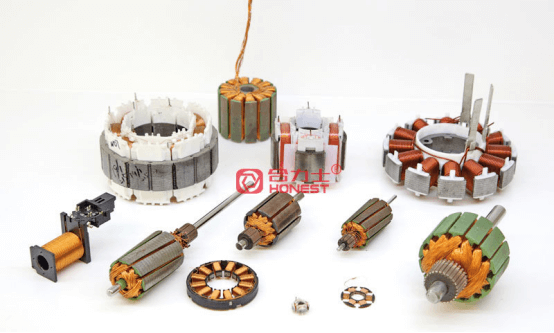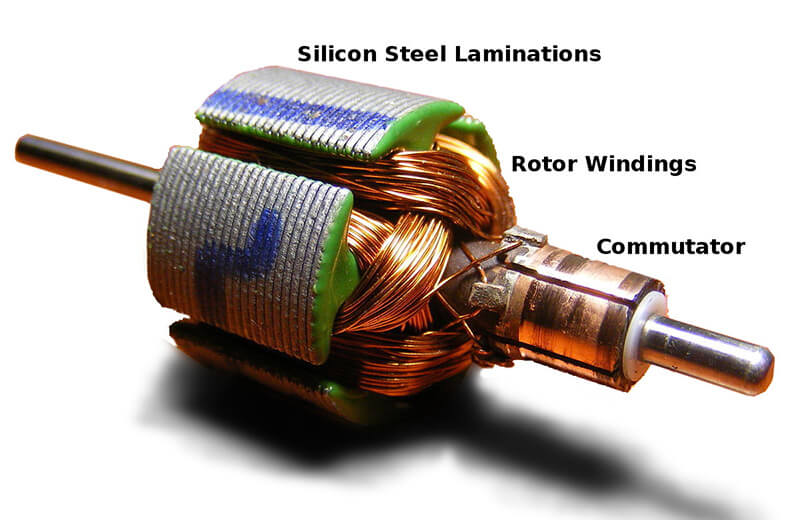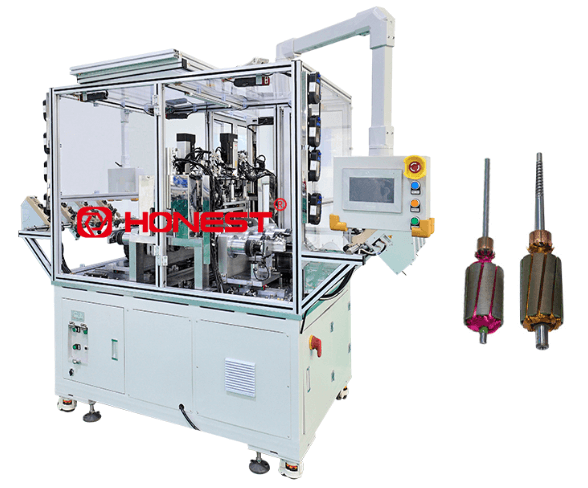The motor rotor is the rotating component of an electric motor, typically composed of a core, shaft, and bearings. It converts electrical energy into mechanical energy through the principle of electromagnetic induction, thereby driving the load to rotate.
Iron Core: The iron core in the motor rotor is also made up of laminated silicon steel sheets, serving to form the motor’s secondary magnetic path. The iron core usually has a winding that, when electrified, generates a magnetic field that interacts with the stator’s magnetic field to produce torque.
Shaft: The shaft is the central component of the motor rotor, typically made from steel or alloy materials. Its role is to support and transmit torque, while also being supported on the motor housing, allowing the entire motor to rotate.
Bearings: Bearings are the critical components connecting the motor's stator and rotor, allowing the rotor to spin freely within the stator.

The motor rotors can be primarily categorized into the following types based on different characteristics:
1.DC Motor Rotor: Comprised of an armature core, windings, commutator brushes, and bearings, its working principle is based on the interaction between the magnetic field produced by the current flowing through the windings and the magnetic field in the armature core, thus achieving motor rotation. DC motor rotors are widely used in electromagnetics, motors, and transmission machinery, characterized by controllable speed, high starting torque, and high precision.
2.Asynchronous Motor Rotor: It is composed of a laminated core, cast-aluminum rotor, and bearings, it is a type of motor that operates on the principle of electromagnetic induction. Its characteristics are a rotational speed slightly less than synchronous speed, with a broad range of applications such as motors and fans.
3.Synchronous Motor Rotor: This type of motor is designed to rotate at a rated speed, achieving uniform rotation through the locking of synchronous magnetic flux and the rotor's magnetic field. Synchronous motor rotors are used in power systems, electrical appliances, ships, and aircraft, and are known for their high starting torque, high conversion efficiency, and stable speed.
4.Stepper Motor Rotor: This is a motor capable of rotating in predetermined increments, and is mainly used in precision instruments, CNC machines, and tax controllers. Stepper motor rotors come in single-phase and three-phase varieties, boasting high precision, convenient control, and smooth operation.
In addition, motor rotors can be classified according to the assembly method of the shaft and impeller, which includes types such as shrink fit, fully forged, composite, and welded types.
The shrink fit rotor features convenient machining, high material utilization, and easy part replacement, but also a large axial dimension, poor shaft rigidity, and higher stress at the shaft hole. The fully forged rotor is characterized by good strength and rigidity, smaller axial dimensions, compact structure, lighter weight, and no impeller vibration under high temperature and high torque loads, but it is difficult to machine, has low material utilization, and relatively higher manufacturing costs. The composite rotor combines the advantages of the fully forged and shrink fit rotors, offering a balanced solution. The welded rotor has characteristics similar to the fully forged rotor but is easier to manufacture than the fully forged rotor, but it requires high welding performance of the material.
A.Materials and Manufacturing Processes for Motor Rotors
The materials used for motor rotors significantly impact the overall performance of the rotor. Here is an introduction to several common rotor materials and their characteristics:
1. Silicon Steel Sheets: Compared to other metallic materials, silicon steel sheets are widely used in motor manufacturing due to their high magnetic permeability, low eddy current losses, and low hysteresis losses.
2. Cast Aluminum: This is a commonly used material for motor rotors, appreciated for its low cost, low density, and good thermal conductivity. However, it has drawbacks such as poor processability, poor corrosion resistance, and inadequate mechanical properties. Therefore, when considering cast aluminum as a material for motor rotors, it is essential to weigh these factors against actual needs.
3. Rare Earth Permanent Magnet Materials: For example, neodymium iron boron, these materials have high coercivity and high magnetic energy products, providing a stable magnetic field and are an ideal choice for high-performance motor rotors.
4. Carbon Fiber Composite Materials: With the increasing demand for high power density and lightweight requirements, carbon fiber materials, as an advanced structural material, are gradually gaining favor. Carbon fiber has extremely high strength, lightweight characteristics, and excellent wear resistance. Its application in rotor structures can significantly reduce the weight of the entire motor, increase power density, and thus improve the motor's dynamic response and the vehicle's fuel efficiency.
5. Composite Materials: Rotors made with composite materials can offer higher strength and stiffness, thereby improving the performance and reliability of the motor.

Manufacturers need to consider factors such as the operating conditions of the motor, performance requirements, cost, and production processes when selecting rotor materials to ensure the overall performance and reliability of the motor. As new materials and manufacturing processes continue to develop, the selection of rotor materials will become more diverse to meet various production requirements.
B.Manufacturing Processes for Motor Rotors
Stamping Process
The stamping process is used to manufacture the silicon steel laminations of the rotor. A stamping machine is utilized to punch the silicon steel into the shape of the rotor. During the stamping process, it is crucial to ensure the dimensional accuracy and consistency of the shape of the silicon steel laminations, avoiding burrs and deformation.
Welding Process
The welding process is employed to join various components of the rotor, such as the rotor shaft and the rotor core, to enhance the overall strength and rigidity of the rotor. Temperature control is essential during the welding process to avoid affecting the material's properties. HONEST typically offers two types of welding methods for customers to choose from: TIG (Tungsten Inert Gas) welding and laser welding, to accommodate different welding requirements. HONEST’s welding machines often use robotic arms for automatic loading and unloading as well as the completion of welding operations and are equipped with corresponding inspection mechanisms to ensure the stability of the welding process and the consistency of welding quality.
Injection Molding Process
The injection molding process is used to inject plastic materials into specific areas of the rotor, such as fixing the magnets. The flowability of the material and the cooling rate during the injection molding process need to be precisely controlled to avoid the formation of bubbles and warping.
Dynamic Balancing Process
During the production of the rotor, various factors may cause imbalances. To ensure the stability and safety of the rotor during high-speed rotation, dynamic balancing calibration is necessary. HONEST’s rotor dynamic balancing test machines ensure rotor balance through weight removal and cutting operations. The testing is done by fixing the shaft and measuring its rotation, and the machines are equipped with a reject area for automatic ejection of unqualified parts, ensuring that they do not affect the subsequent processes.
Every step of the motor rotor production process is meticulously designed and controlled to ensure the performance and service life of the rotor, thereby enhancing the overall performance of the motor and extending its service life. If you have any equipment or production line needs for motor rotor manufacturing, please feel free to contact HONEST. Our professional team is looking forward to serving you.
C. The Future Development Trends and Innovative Directions of Rotor Materials for Electric Motors
1. Material Innovation: As market demands for motor rotor performance continue to rise, manufacturers are seeking rotor materials that are lighter, stronger, more heat-resistant, and offer better performance. Nanomaterials, composite materials, and others may become new choices for the structure of high-speed electric motor rotors in the future, enhancing overall performance.
2. Improvement in Manufacturing Processes: With the continuous development of manufacturing technology, advancements in manufacturing processes will provide more possibilities for the application of new materials. Advanced technologies such as 3D printing and intelligent automation are expected to reduce production costs while increasing production efficiency.
3. Sustainable Material Utilization: In response to calls for carbon neutrality and environmental protection, the selection of rotor materials in the future will seek materials and manufacturing processes that comply with environmental standards. This aligns with the electric vehicle industry's pursuit of environmentally friendly and low-carbon development directions.
The continuous innovation and development of rotor materials bring new development opportunities, but also new challenges. Rotor manufacturers need to balance factors such as performance, cost, and sustainability to find the best material combinations and manufacturing processes.
D. Performance Optimization of Electric Motor Rotors
The electric motor rotor, as an important rotating component, significantly affects the performance of the electric motor. To improve the performance and reliability of the motor, the following methods are commonly used to optimize the performance of the electric motor rotor:
1. Enhancing Materials and Manufacturing Processes: The materials and manufacturing processes of electric motor rotors are continuously improved to provide higher heat resistance, wear resistance, and corrosion resistance. These improvements can effectively extend the service life of the motor and enhance the reliability of the system.
2. Optimizing Design and Structure: By optimizing the design and structure of the electric motor rotor, energy loss and heat generation of the motor can be reduced, improving the efficiency and stability of the system.
3. Enhancing Insulation and Thermal Performance: The insulation and thermal performance of the electric motor rotor have a significant impact on motor performance.
4. Good insulation can prevent short circuits and failures in the motor, while good thermal performance can effectively reduce the motor's temperature, enhancing the reliability and stability of the system.
5. Strengthening Monitoring and Protective Measures: By equipping monitoring and protection systems, the working state and temperature of the motor can be monitored in real-time, and appropriate protective measures can be taken in the event of abnormal conditions, such as automatic power cuts or load reduction.
In all, the development of electric motor rotors in terms of reliability and stability is mainly optimized through measures such as improving materials and manufacturing processes, optimizing design and structure, enhancing insulation and thermal performance, and strengthening monitoring and protective measures.

E. Applications of Electric Motor Rotors Across Various Industries
1. Electric motor rotors are widely applied across different industries due to their high-performance advantages, the details are as follows:
2. Industrial Automation Sector: Motor rotors typically require high precision and reliability to ensure the stable operation of equipment such as robotic arms, conveyor belts, and pumps.
3. Automotive Industry, particularly in the electric vehicle (EV) sector, demands motor rotors that offer high efficiency, high power density, and excellent thermal management. These requirements are essential to accommodate the spatial and weight constraints of vehicles.
4. Household Appliance Industry: Motor rotors are commonly used in compressors and motors for air conditioners, washing machines, refrigerators, and other appliances. These applications necessitate rotors that are cost-effective, efficient, and durable.
In all, the performance and design requirements for electric motor rotors vary significantly across different industries. Manufacturers need to customize production plans according to actual production needs. HONEST is a professional rotor winding machine manufacturer, committed to confirming details and designing solutions that meet the specific needs of customers to fulfill actual production requirements. If you have any needs for motor rotor production equipment, please feel free to contact us at any time, and we will provide you with a detailed introduction and preliminary quotation.






